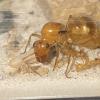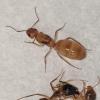Many of the records for C. herculeanus in California seem rather erroneous, at least the ones that have images available online. Additionally, the method of identifying and distinguishing the aforementioned species and C. modoc in the west has previously been on the basis of propodeum coloration - "[C. herculeanus] very closely resembles C. modoc, but may be distinguished by the reddish propodeum," (Shattuck, 1985: pp. 17). The issue with the notion of propodeum color being a valid method of separation becomes useless for aged specimens that have turned brown. However, there is a difference in the gastral vestiture between C. modoc and C. herculeanus.
Recently at my work, where I work in Dr. Roy R. Snelling's Formicidae collection, I found three C. herculeanus specimens hiding among the vast amount of C. modoc. Of the three, two were from California! I have had a strong suspicion for the past few years that California has C. herculeanus after coming across a BugGuide observation of what appeared to be a queen of C. herculeanus. Unfortunately, I am based out of Southern California and don't find it worth driving to the Yosemite area, or further, to locate colonies and procure specimens. The locales I have found are as follows:
United States: California: El Dorado Co.: Fallen Leaf Lake, 1925 m, viii.1920, I. McCracken (LACM). Mariposa Co.: Nevada Fall, "top alt." 1527 m, 25.v.1930, no collector stated (from T.W. Cook collection, possible collected by T.W. Cook or J.C.Bradley) (LACM). Sierra Co.: Yuba Pass, 2050 m, 7.vii.1964, R.E. Scott (LACM). Tuolumne Co.: Yosemite NP, Tuolumne Meadows, 2619 m, 3.vii.2011, B.A. Scavone (BugGuide).
It seems wise to question the validity of the identifications of the other records from museums that do not have images available. Though, with this newfound information, it should be easier for people to go out and locate thriving populations.
Edited by ReignofRage, July 10 2024 - 11:27 PM.






















